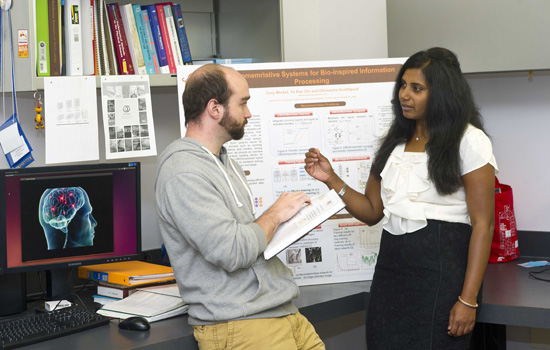Human brain inspires computing system designs
RIT researchers applying neuroscience to develop computer architectures for improved performance, energy efficiency and reliability
A. Sue Weisler
Dhireesha Kudithipudi, associate professor of computer engineering in RIT’s Kate Gleason College of Engineering, and doctoral student Cory Merkel are working toward a new generation of computing systems inspired by the operating principles of the human brain. The two are part of an interdisciplinary team that includes neuroscientists to develop the building blocks for future neuromorphic processors.
What if next-generation computing systems were able to adopt the human brain’s information processing capacity and energy efficiency?
Researchers at Rochester Institute of Technology have begun to answer that question to improve today’s computing capacity using neuromorphic engineering—neuro-inspired computing that combines elements of neuroscience, nanotechnology and intelligent system design. The goal is to re-design computing systems modeled after the brain’s biological processing capabilities to be able to assess and integrate ever-larger quantities of data.
“We are designing a new generation of computing systems, inspired by the operating principles of the human brain,” said Dhireesha Kudithipudi, associate professor of computer engineering in RIT’s Kate Gleason College of Engineering. “The consensus among several leading neuroscientists is that the neocortex is the brain’s primary processing engine, so many of our current projects take inspiration from the principles underlying neocortical processing. We are also exploring the role of subcortical structures in facilitating communication and complex computations within the brain.”
Kudithipudi and members of the NanoComputing Research Lab are pursuing several funded research projects related to neuromorphic engineering, defined as an interdisciplinary approach to developing computing infrastructure based on how the human brain performs its complex functions. Their research approach is multi-tiered spanning neural network architectures, neuromemristive devices, digital/analog circuits, neuropsychology, and development/adaptation of machine learning algorithms for hardware. The team has demonstrated designs for applications such as real-time environmental sensing, load forecasting for smart grids, speech recognition, anomaly detection and object classification.
The different projects focus on developing and using novel memristive devices (computer memory technology), as an essential step toward improved information processing in computer hardware. Kudithipudi’s research team is embedding these devices in abstracted models of cortical and subcortical brain functions. With the advent of big data and the need for increasing computing power to manage this information, computing systems need to be more powerful. New computing systems solutions are being addressed using information from neuroscience, nanotechnology and computer architecture.
“If you think of the current computing systems, they are structured in a very specific paradigm which is called compute-and-storage. You separate what you are computing with where you are storing, known as VonNeumann computing,” she explained. “There is a memory bandwidth bottleneck with these designs. We are moving away from that paradigm, where fundamental elements compute and store information in the same medium similar to biological synapses.”
This past year, Kudithipudi and engineering doctoral student Cory Merkel, through work in the NanoComputing Research Lab in the engineering college, patented a thermal management apparatus technology to help reduce energy and achieve uniform temperature distribution in integrated circuits—similar to how the “brain” maintains a homeostatic state, its balance or equilibrium, in the body. By developing this technology, the team has moved a step closer to better energy efficiencies in computing systems.
Neuromorphic computing could improve multi-modal signal processing defined as the ability to acquire, manage and assess data efficiently from multiple input streams, which is not feasible with a traditional computing systems, she explained. This summer, Kudithipudi and Merkel were awarded the Air Force Summer Faculty Fellowship to study this problem in detail. This has important applications in Department of Defense missions to assess soldiers’ health status on the battlefield, she said.
Kudithipudi and her research team received a grant from Army Research Labs and two others from Air Force Office of Scientific Research to continue this technological advancement; she is also co-principal investigator on a related grant from the National Science Foundation with Santosh Kurinec, professor of microelectronic engineering, also part of RIT’s Kate Gleason College of Engineering. The two faculty-researchers have collaboratively received nearly $235,000 in grant funding to further this technology.
“The brain’s noise tolerance, power efficiency and resiliency of the mammalian brain are remarkable characteristics of evolutionary design. We should be studying the brain as an ideal model for information processing,” she said. “Neuroscientists are attempting to understand the full-scale functional models of the brain, yet nobody has a complete picture of how [the brain] works. This is what makes this research area challenging and exciting. New discoveries are made every day that are shaping a new paradigm of intelligent computer architectures.”
Note: This past summer, Kudithipudi presented research findings about Intelligent Computing with Memristive Circuits and Systems at the Neuro-Inspired Computational Elements Workshop hosted by Sandia Labs.













